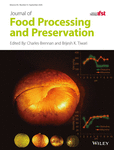Effect of thermosonication in a continuous system on indigenous microflora, milk quality, and consumer acceptance
Abstract
Increasing pasteurized milk shelf life has been a concern for the dairy industry. This study evaluated the effect of pasteurization (control) coupled with thermosonication (treatment) (11.1 s) in a continuous system on shelf-life parameters during storage along with consumer liking. Treatment samples had significantly lower microbial counts than control during storage. Lower free fatty acid and higher pH and casein/total protein values were observed for treatment samples during storage. In a consumer panel, panelists commented on treatment samples having an unknown off-flavor. This unknown flavor declined after 4 days and the consumer liking of treatment samples after 4 days in a second consumer panel was not significantly different than control. Thermosonication in a continuous system coupled with pasteurization successfully improved the overall quality of whole milk as compared to heat only. Future studies could investigate thermosonication conditions to minimize changes in milk sensory attributes.
Practical applications
Thermosonication when applied with pasteurization improves the microbial quality of milk during storage and may extend the shelf life by 2 weeks. Increased shelf life could possibly lead to reduced milk loss on the consumer level by extending the time milk can be consumed. Scale-up systems will need to evaluate the effect of thermosonication at specific residence times and sonication power levels on milk quality during storage and consumer acceptance.
CONFLICT OF INTEREST
The authors have declared no conflicts of interest for this article.




